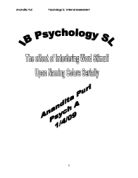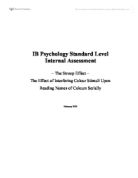Participants
Fifteen participants, ages sixteen to eighteen, wee used as participants in this study (six males and nine females). All of the students are current students in the eleventh and twelfth grade at St. Edmund Preparatory High School, a high school in Brooklyn, New York. Opportunity sampling was used because the participants who were available had a free period when IB Psychology met. Consent forms were given out during that period, and the participants were asked to read it, and sign it. Participants were used from Mr. Malazzo’s band class, because he was absent during the experiment and thus the students were given frees. This was done because school rules prohibited students from being taken out of classes. The results of this experiment can not be generalized to the worldwide population, because although they represented different ethnic backgrounds, it only comes from a specific population of teenage students in the state of New York.
Materials
The materials used were: the baseline stroop card with colors in black font, stroop card with colors in colors that were different, a timer from a G-Shock watch, sheets for marking down the time it took for each stroop card, standardized instructions for all participants, as well as the debriefing statement. (see appendices)
Procedures
Prior to the start of the study, Stroop cards, consent forms, standardized instructions, and debriefing forms were made. On the baseline stroop card and stroop card, names were put in such a way that a word wouldn’t be repeated twice in a row. Two different sets of orders were made because of possible memorization that would occur when one person did the baseline prior to the actual stroop card.
Once participants were found and brought to room 211, the standardized instructions were read to each participant. After this, the baseline stroop card was handed to the participant, then the time it took for each participant to read the stroop cards were recorded in seconds. This was repeated with the actual stroop card, recording the data once again. If a participant were to make a mistake, it was directed that he/she was supposed to fix it.
After a participant finished reading the words, the debriefing statement was read about the purpose of the experiment and the results of the experiment.
Results
Average times of Participants
*Figures rounded to the nearest thousandth of a second
The total number of words to read was 72; 36 for words that were printed in black, and 36 that were in colors different from themselves. The mean number of time it took in seconds for participants reading the words printed in black was 13.705; the words printed in a different color ink than themselves took 2.275 seconds longer, at 15.980 seconds. It is evident that it took longer to read each word; in the ones printed in black, on average, a participant would take .38 seconds, (rounded to the nearest hundredth) and would take .44 seconds per word on the words that were printed in colors other than that of themselves.
Discussion
In the original Stroop effect, J.R. Stroop used 100 words for the colors printed in black and the ones printed in colors; in this experiment, 36 words were used for each, so the time it took would evidently be longer with J.R. Stroop. In the experiment he performed, he saw it took each participant .41 seconds to read each word printed in black, and .43 seconds to read each word printed in color. In this experiment, the results were similar. On average, it took .38 seconds to read each word, in the words printed in black and .44 seconds to read the ones printed in colors. *To account for errors that were left uncorrected, a participant’s time was divided by the amount of words of the sheet, 36, and for each word, that time was doubled, also done by Stroop. There is a slight difference in the quickness of reading the black words from this experiment to J.R. Stroop’s because in his experiment people may have gotten tired towards reading the end of 100 words and therefore took longer. Another possibility was that the sample size used here was smaller and there could be a discrepancy having to do with the lighting of the room, and/or the noise level. If the participant used more words, there would be a more accurate reading. The way in which the participants were recruited may have had an impact on its ability to be generalized because opportunity sampling was used. This experiment has few design flaws, except for the fact that noise, temperature, method of sampling, and lighting couldn’t be controlled to a great extent because of school’s location, school’s rules, etc. A great change would be having a soundproof room where there were no windows, and a mid-temperature, defined as 66 to 72 degrees Fahrenheit. Using a bigger sample size would also increase the ability for the experiment to be generalized better as well as using a sample population that represented a more diverse population. This study showed that anterior cingulated cortex becomes more activated when someone is given conflicting stimuli.
Uncontrollable variables are as followed: since the room has windows facing eastward and this study was only done during the period of IB Psychology, the sun would have a different effect on the participant’s ability to read due to the excess of or lack of natural light. Because the participant had no free periods and was only able to do the experiment during that period, people may have spoken about the nature of the study before they were asked to participate. Since St. Edmund’s is on a busy avenue, car noises and people talking would have an effect on the participant’s ability to concentrate. The temperature of the room couldn’t be controlled; if the room was colder there would be higher concentration, if it were warmer, there would be more sleepiness.
References:
Redding, G. M, Gerjets D. A., Stroop Effect: Interference and Facilitation with Verbal and Manual Responses. Perceptual and Motor Skills, 1977, 11-17.
Stroop, J. R., Studies of Interference in Serial Verbal Reactions. Journal of Experimental Psychology, 18, 643-662.
Appendix I - Instructions
Instructions: Will you please read the word as quickly as possible from left to right; if you make a mistake, please correct it as quickly as possible. Note: You will be timed.
Appendix II- Consent
You are being asked to take part in a research project replicating the original experiment named “The Stroop Effect” by John Ridley Stroop. The purpose of this assignment is to test cognitive interference. The research being done will be done over a period of 3 days. You may choose not to take part in this study, and if you do, your answers will be kept confidential, as well as your identity. No information of name or any sort of information will be given during this study at any point in time. If you do not want to continue with this experiment you may drop out at any course of the experiment, and your information will not be used.
I, ________________________________________________(please print name neatly), give consent to participate in this study and I m aware that these results will be used in an experiment for Ms. Corr’s IB Psychology class.
_____________________________________________________ _______________________________
Signature of Participant Date
(If age is that under 16 years)
_____________________________________________________ _______________________________
Signature of Parent/Guardian Date
Appendix III- Baseline Stroop Sheet
Appendix IV- Stroop Sheet with colors different from the words
Appendix V- Debriefing
This experiment was a replication of the Stroop Effect, previously performed by John Ridley Stroop. Essentially, the goal of this experiment was for participants to read the word in a color other than what the color actually was. This was designed to see if two variables will interfere in the ability to read the given words. It was testing for cognitive interference.
The results were expected to be parallel with the original Stroop Effect. In the original experiment, when the color of the word was different than that of the actual word, it took the participants longer to read the set of given words. When the words were read in normal black ink, it took less time than in a color other than the word. The results of the experiment that you participated in coincided with the expected results.
Appendix VI- Raw Data
See * in discussion
Appendix VII –formulas and calculations
Mean =
total number of times of participants
-------------------------------------------------
total number of participants
for words printed in black for words printed in colors
= 205.58 / 15 = 13.7053333→ rounded to 13.705 = 239.71 / 15 = 15.9800→ rounded to 15.980
13.705/ 36 = .3807 → .38 (seconds per word) 15.980/ 36 = .4438→ .44 (seconds per word)







